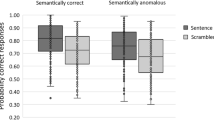Summary
We investigated the semantic interpretation of positive (MORE THAN) and negative (LESS THAN) instructions in a symbolic paired comparison task with an overlearned and finite series of stimuli. French-speaking subjects were asked to indicate which member of month pairs occurred PLUS TOT (earlier), PLUS TARD (later), MOINS TOT (less early), or MOINS TARD (less late) in the year. In Experiment 1, the sign of the comparative instruction (MORE vs. LESS) was kept constant, while its attribute (EARLY vs. LATE) varied. In Experiment 2, the attribute of the instruction was kept constant, while its sign varied. The main results indicate that (1) negative instructions (with adverb LESS) yielded longer response latencies than positive ones (with adverb MORE); this difference was particularly salient on the first experimental session but, on subsequent sessions, it was reduced in Experiment 1 and neutralized in Experiment 2; (2) a symbolic-distance effect was observed on response latency and response accuracy with the four forms of the comparative instruction; (3) violations of monotonicity were noted in the symbolic-distance effect when June was used as a reference month in the analysis; (4) the serial-position effect had the form of a double-bowed curve with three stable anchor points around January, June, and December; and (5) the pattern of semantic-congruity effect with negative instructions was the exact reversal of that obtained with positive instructions; that is, if the month pairs occurred early in the year, response latencies were shorter with the instruction “less late” than with “less early,” whereas if the month pairs occurred late in the year response latencies were shorter with instruction "less early’ than with “less late.” The theoretical implications of these results for Banks' Semantic-coding model and Holyoak's Reference-point model are discussed.
Similar content being viewed by others
References
Banks, W. P. (1977). Encoding and processing of symbolic information in comparative judgments. In G. H. Bower (Ed.), The psychology of learning and motivation (Vol. 11). New York: Academic Press.
Banks, W. P., Clark, H. H., & Lucy, P. (1975). The locus of the semantic congruity effect in comparative judgments. Journal of Experimental Psychology: Human Perception and Performance, 104, 35–47.
Banks, W. P., & Flora, J. (1977). Semantic and perceptual processes in symbolic comparisons. Journal of Experimental Psychology: Human Perception and Performance, 3, 278–290.
Banks, W. P., Fujii, M., & Kayra-Stuart, F. (1976). Semantic congruity effects in comparative judgments of magnitudes of digits. Journal of Experimental Psychology: Human Perception and Performance, 2, 435–447.
Chase, W. G., & Ericsson, K. A. (1982). Skill and working memory. In G. H. Bower (Ed.), Advances in learning and motivation (Vol. 16). New York: Academic Press.
Clark, H. H. (1969). Linguistic processes in deductive reasoning. Psychological Review, 76, 387–404.
Clark, H. H., & Clark, E. V. (1977). Psychology and language. New York: Harcourt, Brace, Jovanovich, Inc.
Corcia, M. (1989). Facteurs de complexité sémantique dans la compréhension des énoncés comparatifs en anglais chez L'enfant [Factors of semantic complexity in the comprehension of English comparative statements by children]. Bulletin de Psychologie, XLI (383), 291–301.
Desrochers, A., & Petrusic, W. M. (1983). Comprehension effects in comparative judgments. In J. C. Yuille (Ed.), Imagery, memory and cognition: Essays in honour of Allan Paivio. Hillsdale, NJ: Lawrence Erlbaum Associates.
Fairbanks, B. A. (1969). Experiments on the temporal aspects of number perception (Doctoral dissertation, University of Arizona, 1969). Dissertation Abstracts International, 30, 403 b (University Microfilms No. 60-10,052).
Flores D'Arcais, G. B. (1974). Semantic and perceptual factors in the processing of comparative sentences. Italian Journal of Psychology, 1, 267–303.
Friedman, W. J. (1983). Image and verbal processes in reasoning about the months of the year. Journal of Experimental Psychology: Learning, Memory, and Cognition, 9, 650–666.
Friedman, W. J. (1984). Analog and semantic models of judgments about the months of the year. Memory & Cognition, 12, 306–313.
Friedman, W. J. (1990). About time: Inventing the fourth dimension. Cambridge, MA: The MIT Press.
Grenzebach, A. P., & McDonald, J. E. (1992). Alphabetic sequence decisions for letter pairs with separations of one to three letters. Journal of Experimental Psychology: Learning, Memory, and Cognition, 18, 865–872.
Holyoak, K. (1978). Comparative judgments with numerical reference points. Cognitive Psychology, 10, 203–243.
Holyoak, K. J., & Patterson, K. K. (1981). A positional discriminability model of linear-order judgments. Journal of Experimental Psychology: Human Perception and Performance, 7, 1283–1302.
Jamieson, D. G., & Petrusic, W. M. (1975). Relational judgments with remembered stimuli. Perception & Psychophysics, 18, 373–378.
Klahr, D., Chase, W. G., & Lovelace, E. A. (1983). Structure and process in alphabetic retrieval. Journal of Experimental Psychology: Learning, Memory, and Cognition, 9, 462–477.
Le Ny, J.-F. (1979). La sémantique psychologique [Psychological semantics]. Paris: Presses Universitaires de France.
Marks, D. F. (1972). Relative judgment: A phenomenon and a theory. Perception & Psychophysics, 11, 156–160.
McNamara, T. P., & Miller, D. L. (1989). Attributes of theories of meaning. Psychological Bulletin, 106, 355–376.
Moyer, R. S., & Dumais, S. T. (1978). Mental comparison. In G. H. Bower (Ed.), The psychology of learning and motivation (Vol. 12). New York: Academic Press.
Petrusic, W. M., & Baranski, J. V. (1989). Semantic congruity effects in perceptual comparisons. Perception & Psychophysics, 45, 439–452.
Poltrock, S. E. (1989). A random walk model of digit comparison. Journal of Mathematical Psychology, 33, 131–162.
Segui, J., & Bertoncini, J. (1978). La vérification des phrases comparatives [Verification of comparative sentences]. L'Année Psychologique, 78, 129–144.
Seymour, P. H. K. (1980a). Semantic and structural coding of the months. British Journal of Psychology, 71, 379–393.
Seymour, P. H. K. (1980b). Internal representation of the months. Psychological Research, 42, 255–273.
Woocher, F. D., Glass, A. L., & Holyoak, K. J. (1978). Positional discriminability in linear orderings. Memory & Cognition, 6, 165–173.
Author information
Authors and Affiliations
Rights and permissions
About this article
Cite this article
Gélinas, C.S., Desrochers, A. Positive and negative instructions in symbolic paired comparisons with the months of the year. Psychol. Res 55, 40–51 (1993). https://doi.org/10.1007/BF00419892
Received:
Accepted:
Issue Date:
DOI: https://doi.org/10.1007/BF00419892




